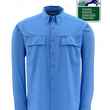The G. Loomis NRX, first announced in 2010, is one of the most heralded fly rods of all time. That first year, G. Loomis sold more NRX rods than any prior rod debut. The NRX was Loomis' successor to the also wildly popular GLX, leaving it with big shoes to fill. But fill them it did, and for almost a decade, while some other rod makers churned out one new flagship fly rod after another, the NRX remained among—if not squarely atop—the pantheon of high-performance fly rods.
If the NRX faded from the conversation these last couple of years, it was likely due only to Loomis' own 2016 introduction of the oddly-named, price barrier-shattering Asquith which, perhaps unsurprisingly, also turned out to be one of the finest fishing tools on the market.
When the Asquith hit the market, some six years after the NRX's introduction, and was positioned to lead Loomis' fly rod lineup, many speculated that Asquith was the successor to the brand's longtime flagship offering. But the folks in Woodland, Washington were clear from the start: the partially Shimano-built, co-branded Asquith was its own unique project. When and what would replace the NRX was to be determined.
With the introduction of the new NRX+ (or NRX "Plus"), G. Loomis has finally answered the question of what will succeed its longtime standard-setter. Preserving the namesake of its almost decade-long best-seller, the new NRX+, according to Loomis, "reimagines" the proprietary compound taper design found in the NRX. Originally employed to reduce swing weight and failure rates, Loomis says that, this time around, it has applied a similar process to yield improvements in loading efficiency and rod feedback. The result, the rod maker says, is something akin to an NRX that's lighter, more powerful, features faster recovery and, perhaps most importantly, offers a noticeably bigger "sweet spot" at all casting distances.
The "NRX+ provides the power, line speed, and loop stability expected from modern fast-action rods, without compromising 'feel' and finesse in the short game," says G. Loomis.


As marketers do with every new fly rod introduction, the folks at G. Loomis have come up with a bunch of fancy names for the brand's advancements in graphite, resins and blank construction. Much as with the modification and continuation of the NRX namesake, Loomis has continued the namesake of its tech. The NRX's Mega Modulus graphite has been replaced with Mega Modulus+, which Loomis reports is 15% lighter than the graphite matrix in the original NRX. The GL7 resin in the NRX is now replaced with GL8 resin in the NRX+, which reportedly offers the same strength and impact resistance as the GL7 while requiring less material, which in turn reduces overall weight.
This is a good time to point out that tapers, graphite matrixes, resins and so on, if you're not already clear, are what make fly rods what they are. Whether a rod is fast, slow, flexes mostly in the tip, bends deep into the butt, recovers quickly or slowly, offers great "feel" and feedback or is a dead-weight broomstick ... all of these things are, at least in a very significant way, determined by those core building blocks of a fly rod. They're also bits of technology and spec that almost everyone in the world of fly rods pretends to understand but, in truth, almost always doesn't.

The good news is that most anglers need not understand tapers and graphite matrixes and resins. If marketing mumbo-jumbo on rod tech—rather than first-hand casting experience, word of mouth and trustworthy recommendations, for instance—is how you're making your buying decisions, you're doing something wrong. Rod makers, on the other hand, most certainly need to understand these core technologies. And the good news, for NRX faithfuls and NRX+ hopefuls, is that longtime G. Loomis rod designer Steve Rajeff and the other folks at Loomis felt that the advancements they had developed in these arenas finally represented an opportunity to build a better rod than the NRX they had been confidently churning out of their Woodland, WA factory (and winning awards with) for almost a decade—perhaps as long as any rod maker has ever kept a rod model positioned atop their lineup.
Like the original NRX, the NRX+ lineup is split into 4 distinct categories—the NRX+, NRX+ LP (Light Presentation), NRX+ S (Saltwater) and NRX+ Switch/Spey—comprised of 26 individual rod models. Pricing ranges from $795 to $975. Available October 2019.
For more information on the entire NRX+ lineup, visit G. Loomis.































Comments